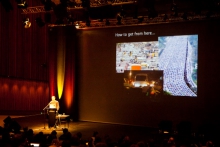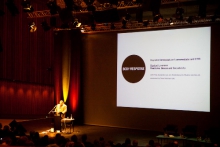Digital Liveness – Realtime, Desire and Sociability (Interface Keynote-Lecture tm / CTM - Track 1)
Digital Liveness – Realtime, Desire and Sociability (Interface Keynote-Lecture tm / CTM - Track 1)
Digital Liveness – Realtime, Desire and Sociability
Interface Keynote-Lecture transmediale and CTM (club transmediale) (Track 1)
Participants: Philip Auslander (us), Eric Kluitenberg (nl), Mushon Zer Aviv (il)
Moderation: Drew Hemment (uk)
The desire to transcend distance and separation has accompanied the history of media technology for many centuries. One manifestation of this desire to transcend the limitations of living experience is the longing for immediate contact with people and audiences across any distance or divide. Today internet-based techniques of tele-connection, live streams, and various forms of real-time interfaces and networks seem to create a ubiquitous presence, replacing the actual physical co-presence of here and now. At the same time this 'presence in absence' creates an invisible audience that becomes the curcial definer for the success and failures of our mediated social life.
With this interface keynote between CTM (club transmediale) and transmediale festival we want to bridge our two festival topics based on evolved qualities of liveness and presence. The internationally known researchers and collaborative practicioners explore the new social and performative qualities of internet-based realtime media and networks and how they re-define our understanding of presence, encounter and sociability.
Could playful interfaces, allowing audiences to interact across different localities have helped to create this sense of co-presence?
What are the new rules of communication facing an invisible audience?
How can we understand the fundamental shifts in human sociability presented by new mediated publics?
Is the idea of a replacement of physical encounters by mediated encounters an illusion?
Could a new form of public assembly emerge from the new distributed space-time configurations?


